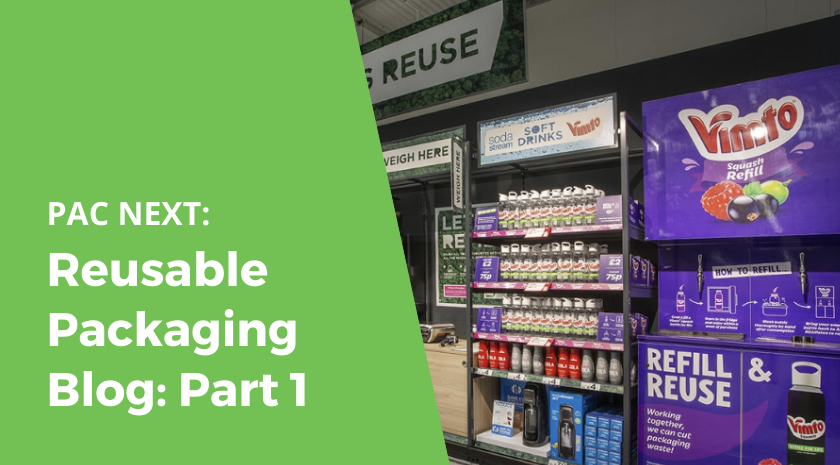From the Desk of Andrew Macdonald, PAC NEXT Project Manager:
Shedding Light on Reusable Packaging Models:
Opportunities & Challenges in Canada and Beyond
Among the dizzying array of proposed solutions to packaging waste, reusable packaging systems offer valuable opportunities. However, despite increased investment, credible research, some enabling public policy, and a burgeoning array of start-up, pilot and scaling initiatives, reuse remains underrepresented in the solution arena. In two blog posts I’ll shed light on opportunities and challenges related to reusable packaging in Canada, and beyond. Part one sets the stage: What is reusable packaging? Who considers it important, and why?
What is reusable packaging?
A 2021 Zero Waste Europe report defines reusable packaging this way:
“packaging that has been conceived, designed and placed on the market to accomplish within its life cycle multiple trips or rotations by being refilled or reused for the same purpose for which it was conceived (DIRECTIVE (EU) 2018/852).”
The packaging is just one part of a system that includes some or all of: collection, washing, sanitizing, refilling, returning, and tracking — the logistics of how the reuse/refill actually happens. And it’s happening in many ways, with many actors. The Ellen MacArthur Foundation’s Guide to Packaging Solutions organizes reuse into five categories. Here are just a few examples to illustrate them:
With Refill On-the Go we see examples to mainstream a historically niche bulk model: in 2021 UK’s Asda supermarket added 50 product lines to its refill centre. Affordability is critical for widespread consumer adoption of reuse systems: importantly, Asda aims to offer these products at the same price as packaged goods.
Retailers often avoid dispensers due to health and safety considerations, which have become all the more pressing during the pandemic. The Czech company MIWA aims to mitigate retailer risk with sealed reusable capsules as part of a modular refill system. A Canadian start-up The Aggressive Good offers reusable cartridges linked to a cloud-based database. With Refill At Home there is considerable activity in the personal care and cleaning segments, examples including Canada’s Refillery Market and Saponetti.
There are many new and growing Return On-the-Go models. Canadian food service sector examples include: Suppli, A Friendlier Company, and Muuse in partnership with DreamZero. Canada’s Circulr offers reuse logistics support, and a global grocery sector example is Tesco’s recent launch of Loop in ten stores.
Return From Home models include a meal kit option by Vancouver’s Fresh Prep, and Repack’s reusable e-commerce solutions — Canada Post has approved its packs for circulation and in 2020 ran a pilot with a Montreal brand. Orbis sells into the Canadian marketplace, and offers reusable Business-to-Business (B2B) transit packaging.
Who considers reusable packaging important, and why?
PAC is an Implementation Partner of the Canada Plastics Pact (CPP) — one of eleven pacts in a global network, led by the Ellen MacArthur Foundation (EMF), which brings together businesses, governments, NGOs and others behind a set of 2025 plastics circular economy targets. EMF’s Guide to Packaging Solutions describes a mindset for upstream innovation — a call to prioritize the prevention of waste in the first place:
The idea of waste prevention is embedded in the familiar three Rs: reduce, reuse, recycle — a hierarchy to guide decision-making that took root after the first Earth Day in 1970. More recently, circular economy thinkers have expanded the Rs to include important practices such as rethink, repair and remanufacture. Reuse is reflected in the EMF Guide’s three core strategies of “elimination, reuse and material circulation”, and in the CPP’s target “to support efforts towards 100% of plastic packaging being designed to be reusable, recyclable or compostable”.
The Canadian federal government also acknowledges reuse as part of the solution to plastic waste. Environment and Climate Change Canada (ECCC) is a Canada Plastics Pact partner, and reuse is cited in relevant federal publications, including Phase 2 of the Canada-wide Action Plan on Zero Plastic Waste, and this related Discussion Paper. The Phase 2 document shows the following hierarchy, which links waste management approaches with a scale of preferability and value:
The Discussion Paper identified the first set of single-use plastic items that meet the requirements for a ban or restriction. Reusable packaging is a potential alternative for some of these items, like food service ware. Of note too is ECCC’s 2021 support for “A Guide to Opening and Running a Bulk-Reuse Refillery in Canada.”
As noted here, many local governments in Canada have instituted, or plan to institute, single-use plastic reduction initiatives, with varying exemptions and requirements for the alternatives. Examples include the City of Toronto’s Single-Use and Takeaway Reduction Strategy, and the City of Vancouver’s Single-Use Reduction Strategy. Vancouver’s regulations start to take effect in January, 2022, so we may see more initiatives like A&W’s recently announced exchangeable cup pilot. Of note too, is the California refillable beverage container bill, AB 962, which was just signed into law.
In the investment space Closed Loop Partners (CLP) describes the “comeback of reuse”, and is engaged with reusable packaging in several ways, including the NextGen Consortium to rethink food service packaging, research, direct investment, and co-sponsoring a first ever awards event in the US.
Reuse is important to the Ellen MacArthur Foundation, Canada Plastics Pact signatories, governments and investors for good reason: EMF’s 2019 Reuse: Rethinking Packaging report estimates that, for at least 20% of plastic packaging, reuse models offer economically attractive business opportunities. The report challenges the notion of reuse models as quaint and unviable, and points to economic benefits (e.g., brand loyalty, user experience) and environmental benefits (e.g., the reduction of negative environmental impacts like greenhouse gas emissions and litter). Consumers recognize these benefits too, and many say reusable packaging is important to them.
That said, EMF’s 2020 Global Commitment Progress Report shows the share of reusable plastic packaging at just under 2% in 2019, with little year-over-year progress.
Compared with single-use options, reusable packaging solutions are preferred — economically and environmentally — only in certain situations. So, what are the preferred situations, and what are key factors influencing broader adoption? I’ll offer some insight on these questions in Part 2.
Join our workshop and speaker sessions at PACKEX Toronto | November 9 – 11.







